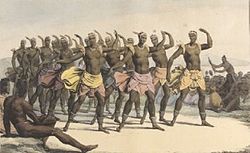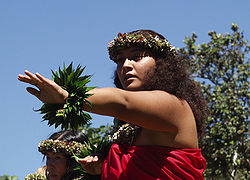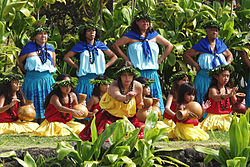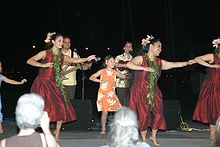- Hula
-
Hula (
 /ˈhuːlə/) is a dance form accompanied by chant (oli) or song (mele). It was developed in the Hawaiian Islands by the Polynesians who originally settled there. The hula dramatizes or portrays the words of the oli or mele in a visual dance form.
/ˈhuːlə/) is a dance form accompanied by chant (oli) or song (mele). It was developed in the Hawaiian Islands by the Polynesians who originally settled there. The hula dramatizes or portrays the words of the oli or mele in a visual dance form.There are many sub-styles of hula, with the main two categories being Hula 'Auana and Hula Kahiko. Ancient hula, as performed before Western encounters with Hawaiʻi, is called kahiko. It is accompanied by chant and traditional instruments. Hula as it evolved under Western influence, in the 19th and 20th centuries, is called ʻauana (a word that means "to wander or drift"). It is accompanied by song and Western-influenced musical instruments such as the guitar, the ʻukulele, and the double bass.
Terminology for two main additional categories is beginning to enter the hula lexicon: "Monarchy" includes many hula which were composed and choreographed during the 19th century. During that time the influx of Western culture created significant changes in the formal Hawaiian arts, including hula. "Ai Kahiko", meaning "in the ancient style" are those hula written in the 20th and 21st centuries that follow the stylistic protocols of the ancient hula kahiko.
There are also two main positions of a hula dance - either sitting (noho dance) or standing (luna dance). Some dances utilize both forms.
Hula is taught in schools or groups called hālau. The teacher of hula is the kumu hula, where kumu means source of knowledge, or literally just teacher. Often you will find that there is a hierarchy in hula schools - starting with the kumu (teacher), alaka'i (leader), kokua (helpers), and then the 'olapa (dancers) or haumana (students). This is not for every hālau, but it does occur often. Most, if not all, hula halau(s) have a permission chant in order to enter wherever they may practice. They will collectively chant their entrance chant, then wait for the kumu to respond with the entrance chant, once he or she is finished, the students may enter. One well known and often used entrance or permission chant is Kunihi Ka Mauna/Tunihi Ta Mauna.
Hula dancing is a complex art form, and there are many hand motions used to represent the words in a song or chant. For example, hand movements can signify aspects of nature, such as the swaying of a tree in the breeze or a wave in the ocean, or a feeling or emotion, such as fondness or yearning. Foot and hip movements often pull from a basic library of steps including the kaholo, ka'o, kawelu, hela, 'uwehe, and 'ami.
There are other related dances (tamure, hura, 'aparima, 'ote'a, haka, kapa haka, poi, Fa'ataupati, Tau'olunga, and Lakalaka) that come from other Polynesian islands such as Tahiti, The Cook Islands, Samoa, Tonga and Aotearoa (New Zealand); however, the hula is unique to the Hawaiian Islands.
Contents
Hula Kahiko
Hula kahiko, often defined as those hula composed prior to 1893 which do not include modern instrumentation (such as guitar, `ukulele, etc.), encompasses an enormous variety of styles and moods, from the solemn and sacred to the frivolous. Many hula were created to praise the chiefs and performed in their honor, or for their entertainment. Types of hula kahiko include ʻālaʻapapa, haʻa, ʻolapa, and many others.
Many hula dances are considered to be a religious performance, as they are dedicated to or honoring a Hawaiian goddess or god. As was true of ceremonies at the heiau, the platform temple, even a minor error was considered to invalidate the performance. It might even be a presage of bad luck or have dire consequences. Dancers who were learning to do such hula necessarily made many mistakes. Hence they were ritually secluded and put under the protection of the goddess Laka during the learning period. Ceremonies marked the successful learning of the hula and the emergence from seclusion.
Hula kahiko is performed today by dancing to the historical chants. Many hula kahiko are characterized by traditional costuming, by an austere look, and a reverence for their spiritual roots.
Chants
Hawaiian history was oral history. It was codified in genealogies and chants, which were memorized and passed down. In the absence of a written language, this was the only available method of ensuring accuracy. Chants told the stories of creation, mythology, royalty, and other significant events and people.
Instruments and implements
- Ipu—single gourd drum
- Ipu heke—double gourd drum
- Pahu—sharkskin covered drum; considered sacred
- Pūniu—small knee drum made of a coconut shell with fish skin (kala) cover
- ʻIliʻili—water-worn lava stone used as castanets
- ʻUlīʻulī—feathered gourd rattles (also ʻulili)
- Pūʻili—split bamboo sticks
- Kālaʻau—rhythm sticks
The dog's-tooth anklets sometimes worn by male dancers could also be considered instruments, as they underlined the sounds of stamping feet.
Costumes
Traditional female dancers wore the everyday pāʻū, or wrapped skirt, but were topless. Today this form of dress has been altered. As a sign of lavish display, the pāʻū might be much longer than the usual length of tapa, or barkcloth, which was just long enough to go around the waist. Visitors report seeing dancers swathed in many yards of tapa, enough to increase their circumference substantially. Dancers might also wear decorations such as necklaces, bracelets, and anklets, as well as many lei (in the form of headpieces (leipo'o), necklaces, bracelets, and anklets (kupe'e)).
Traditional male dancers wore the everyday malo, or loincloth. Again, they might wear bulky malo made of many yards of tapa. They also wore necklaces, bracelets, anklets, and lei.
The materials for the lei worn in performance were gathered in the forest, after prayers to Laka and the forest gods had been chanted.
The lei and tapa worn for sacred hula were considered imbued with the sacredness of the dance, and were not to be worn after the performance. Lei were typically left on the small altar to Laka found in every hālau, as offerings.
Performances
Hula performed for spontaneous daily amusement or family feasts were attended with no particular ceremony. However, hula performed as entertainment for chiefs were anxious affairs. High chiefs typically traveled from one place to another within their domains. Each locality had to house, feed, and amuse the chief and his or her entourage. Hula performances were a form of fealty, and often of flattery to the chief. During the performances the males would start off and the females would come later to close the show off. There were hula celebrating his lineage, his name, and even his genitals (hula maʻi). Sacred hula, celebrating Hawaiian gods, were also danced. All these performances must be completed without error (which would be both unlucky and disrespectful).
Visiting chiefs from other domains would also be honored with hula performances. This courtesy was often extended to important Western visitors.
Hula ʻauana
Modern hula arose from adaptation of traditional hula ideas (dance and mele) to Western influences. The primary influences were Christian morality and melodic harmony. Hula ʻauana still tells or comments on a story, but the stories may include events since the 1800s. The costumes of the women dancers are less revealing and the music is heavily Western-influenced.
Songs
The mele of hula ʻauana are generally sung as if they were popular music. A lead voice sings in a major scale, with occasional harmony parts.
The subject of the songs is as broad as the range of human experience. People write mele hula ʻauana to comment on significant people, places or events or simply to express an emotion or idea.
Instruments
The musicians performing hula ʻauana will typically use portable acoustic stringed instruments.
- ʻUkulele—four-, six- or eight-stringed, used to maintain the rhythm if there are no other instruments
- Guitar—used as part of the rhythm section, or as a lead instrument
- Steel guitar—accents the vocalist
- Bass—maintains the rhythm
Occasional hula ʻauana call for the dancers to use implements, in which case they will use the same instruments as for hula kahiko. You will often see a hula 'auana with the dancers using ʻUlīʻulī (feathered gourd rattle).
Costumes
Costumes play a role in illustrating the hula instructor's interpretation of the mele. While there is some freedom of choice, most hālau follow the accepted costuming traditions. Women generally wear skirts or dresses of some sort. Men may wear long or short pants, skirts, or a malo (a cloth wrapped under and around the crotch). For slow, graceful dances, the dancers will wear formal clothing such as a muʻumuʻu for women and a sash for men. A fast, lively, "rascal" song will be performed by dancers in more revealing or festive attire. The hula kahiko is always performed with bare feet, but the hula ʻauana can be performed with bare feet or shoes.
History of hula
Legendary origins
 Female dancers of the Sandwich Islands depicted by Louis Choris, the artist aboard the Russian ship Rurick, which visited Hawai'i in 1816
Female dancers of the Sandwich Islands depicted by Louis Choris, the artist aboard the Russian ship Rurick, which visited Hawai'i in 1816
There are various legends surrounding the origins of hula.
According to one Hawaiian legend, Laka, goddess of the hula, gave birth to the dance on the island of Molokaʻi, at a sacred place in Kaʻana. After Laka died, her remains were hidden beneath the hill Puʻu Nana.
Another story tells of Hiʻiaka, who danced to appease her fiery sister, the volcano goddess Pele. This story locates the source of the hula on Hawaiʻi, in the Puna district at the Hāʻena shoreline. The ancient hula Ke Haʻa Ala Puna describes this event.
Another story is when Pele, the goddess of fire was trying to find a home for herself running away from her sister Namakaokaha'i (the goddess of the oceans) when she finally found an island where she couldn't be touched by the waves. There at chain of craters on the island of Hawai'i she danced the first dance of hula signifying that she finally won.
One story is that Pele asked Laka to amuse her because Pele was bored. So right away Laka got up and began to move gracefully, acting out silently events they both knew. Pele enjoyed this and was fascinated thus Hula was born.
During the 19th century
American Protestant missionaries, who arrived in 1820, denounced the hula as a heathen dance. The newly Christianized aliʻi (royalty and nobility) were urged to ban the hula—which they did. However, many of them continued to privately patronize the hula. By the 1850s, public hula was regulated by a system of licensing.
The Hawaiian performing arts had a resurgence during the reign of King David Kalākaua (1874–1891), who encouraged the traditional arts. With the Princess Liliokolani who devoted herself to the old ways, as the patron of the ancients chants (mele, hula), she stressed the importance to revive the diminishing culture of their ancestors within the damaging influence of foreigners and modernism that was forever changing Hawaii.
Practitioners merged Hawaiian poetry, chanted vocal performance, dance movements and costumes to create the new form, the hula kuʻi (kuʻi means "to combine old and new"). The pahu appears not to have been used in hula kuʻi, evidently because its sacredness was respected by practitioners; the ipu gourd (Lagenaria sicenaria) was the indigenous instrument most closely associated with hula kuʻi.
Ritual and prayer surrounded all aspects of hula training and practice, even as late as the early 20th century. Teachers and students were dedicated to the goddess of the hula, Laka.
20th century hula dancing
Hula changed drastically in the early 20th century as it was featured in tourist spectacles, such as the Kodak Hula Show, and in Hollywood films. However, a more traditional hula was maintained in small circles by older practitioners. There has been a renewed interest in hula, both traditional and modern, since the 1970s and the Hawaiian Renaissance.
Contemporary hula festivals
- Moku O Keawe International Festival is a 4-day celebration of hula and the arts of hula held annually in November at Waikoloa Beach Resort, Island of Hawaii. [1] The Festival includes authentic workshops taught by noted kumu, with focus on hula and Hawaiian musical instruments.
- Ka Hula Piko, held every May on Molokaʻi.
- Merrie Monarch Festival is a week-long cultural festival and hula competition in Hilo on the Big Island of Hawaiʻi. Where the noted Miss Aloha Hula competition occurs.
- Hula Workshop, Hoʻike and Hawaiian Festival, held every July in Vancouver, WA.
- E Hula Mau, held every Labor Day Weekend (September) in Long Beach, CA.
- World Invitational Hula Festival, a 3 day art and culture contest held every November on Oahu, Hawaii in the Waikiki Shell.
- "Share da Aloha", held in February at Saddleback Church in Lake Forest, CA. http://www.ohanapraise.com/
- The Iā 'Oe E Ka Lā Hula Competition and Festival is held annually at the Alameda County Fairgrounds in Pleasanton, California. Friday thru Sunday, traditionally the first weekend in November. http://www.kumuhulaassociation.com
- The May Day Festival is held annually at the Alameda County Fairgrounds in Pleasanton, California. Traditionally the second Saturday in May, as of 2006 held both Saturday and Sunday remaining the second weekend in May. http://www.kumuhulaassociation.com
- "Tahiti Fete" held during the summer in July, San Jose, CA http://www.tahitifete.com/
Films
- Kumu Hula: Keepers of a Culture (1999) Directed by Robert Mugge.
- Holo Mai Pele - Hālau ō Kekuhi (2000) Directed by Catherine Tatge
- Lilo & Stitch (2002) By Walt Disney Pictures and Lilo & Stitch 2 by Walt Disney Pictures
- American Aloha : Hula Beyond Hawaiʻi (2003) By Lisette Marie Flannery & Evann Siebens
- Hula Girls (2006)
Books
- Nathaniel Emerson, 'The Myth of Pele and Hi'iaka'. This book includes the original Hawaiian of the Pele and Hi'iaka myth and as such provides an invaluable resource for language students and others.
- Nathaniel Emerson, 'The Unwritten Literature of Hawaii'. Many of the original Hawaiian hula chants, together with Mr. Emerson's descriptions of how they were danced in the nineteenth century.
- Amy Stillman, "Hula `Ala`apapa". An analysis of the `Ala`apapa style of sacred hula.
- Ishmael W. Stagner: Kumu hula : roots and branches. Honolulu : Island Heritage Pub., 2011. ISBN 9781597006217
References
External links
- Everything Related To Hula Dancing, Hula History & Hula Theory
- Hawaiian Music and Hula Archives
- Hula Preservation Society
- European Hula Festival
- Ka`ahele Hawai`i
- "Where Tradition Holds Sway" Article about "Ka Hula Piko" on Molokai, by Jill Engledow. Maui No Ka 'Oi Magazine Vol. 11 No.2 (March 2007).
List of resources about traditional arts and culture of OceaniaArt ahu · Australia · Austronesia · Cook Islands · Hawaiʻi · kapa (Hawaiʻi) · lei (Hawaii) · magimagi · Māori · moai · New Zealand · nguzu nguzu · Oceania · Papua New Guinea · reimiro · tā moko · tapa ["masi" (Fiji), "ngatu" (Tonga), "siapo" (Sāmoa), " ʻuha" (Rotuma)] · tabua · ta'ovala · tattoo · tēfui · tivaivaiBroad culture Geo-specific, general Australia · Australian Aboriginal astronomy · Austronesia · Caroline Islands, -Pwo · Chatham Islands · Cook Islands · Easter Island · Fiji, -Lau Islands, -traditions and ceremonies · Guam · Hawaiʻi, -Lomilomi massage · Kiribati · French Polynesia's Marquesas Islands · Marshall Islands, -Stick charts of · Federated States of Micronesia · Nauru · New Caledonia · New Zealand · Niue · Norfolk Island · Palau · Papua New Guinea · Pitcairn Islands · Sāmoa · Solomon Islands · Tonga · Torres Strait Islands · Tuvalu · Vanuatu · Wallis and Futuna · Yap, -navigation, -Weriyeng navigation schoolCanoes Aboriginal Dugout · Alingano Maisu · Drua · Dugout (boat) · Hawaiʻiloa · Hōkūleʻa · Modern Hawaiian outrigger · Māori migration · Outrigger · Polynesian sailing · Proa · Waka,-List of · WalapDance Festivals Australia's Garma Festival · Hawaiʻi's Aloha Festivals, Merrie Monarch Festival, and World Invitational Hula Festival · Fiji · New Zealand's Pasifika Festival · The Pacific Community's Festival of Pacific Arts · Festivals in Papua New GuineaLanguages by areaLanguages of Oceania Sovereign states - Australia
- East Timor (Timor-Leste)
- Fiji
- Indonesia
- Kiribati
- Marshall Islands
- Federated States of Micronesia
- Nauru
- New Zealand
- Palau
- Papua New Guinea
- Samoa
- Solomon Islands
- Tonga
- Tuvalu
- Vanuatu
Dependencies and
other territories- American Samoa
- Christmas Island
- Cocos (Keeling) Islands
- Cook Islands
- Easter Island
- French Polynesia
- Guam
- Hawaii
- New Caledonia
- Niue
- Norfolk Island
- Northern Mariana Islands
- Pitcairn Islands
- Tokelau
- Wallis and Futuna
by categoryLiterature Literature of Oceania Sovereign states - Australia
- East Timor (Timor-Leste)
- Fiji
- Indonesia
- Kiribati
- Marshall Islands
- Federated States of Micronesia
- Nauru
- New Zealand
- Palau
- Papua New Guinea
- Samoa
- Solomon Islands
- Tonga
- Tuvalu
- Vanuatu
Dependencies and
other territories- American Samoa
- Christmas Island
- Cocos (Keeling) Islands
- Cook Islands
- Easter Island
- French Polynesia
- Guam
- Hawaii
- New Caledonia
- Niue
- Norfolk Island
- Northern Mariana Islands
- Pitcairn Islands
- Tokelau
- Wallis and Futuna
Music Austral Islands (French Polynesia) · Australia · Austronesia · Cook Islands · Easter Island · Fiji · Guam · Hawaiʻi · Kiribati · Lali · Māori · Melanesia · Northern Mariana Islands · Micronesia · Federated States of Micronesia · Nauru · New Caledonia · New Zealand · Niue · Palau · Papua New Guinea · Polynesia · Sāmoa · Slit drum · Solomon Islands · Tahiti · Tokelau · Tonga · Tuvalu · Vanuatu · Wallis and FutunaMythology Australian Aboriginal · Fijian · Māori · Melanesian · Menehune · Micronesian · Oceanian legendary creatures · Polynesian · Rapa Nui · VanuatuPeople Indigneous Australian · Austronesian · Chamorro · Chatham Islander (Moriori or Rekohu) · Fijian · Hawaiian (kānaka maoli) · Māori · Marshallese · Melanesian · Micronesian · Negrito · Norfolk Islander · Papuan · Polynesian · Indigenous Polynesian (Mā’ohi) · Rapanui · Rotuman · Samoan · Tahitian · Tongan · Torres Strait IslanderReligion Religion in Oceania Sovereign states Dependencies and
other territories- American Samoa
- Christmas Island
- Cocos (Keeling) Islands
- Cook Islands
- Easter Island
- French Polynesia
- Guam
- Hawaii
- New Caledonia
- Niue
- Norfolk Island
- Northern Mariana Islands
- Pitcairn Islands
- Tokelau
- Wallis and Futuna
Not included: Oceanian: cinema, (indigenous) currency, dress, folkore, cuisine. Also see Category:Oceanian culture.Categories:- Hawaiian music
- Dance in the United States
- Dances of Polynesia
- Tiki culture
- Hawaiian words and phrases
Wikimedia Foundation. 2010.












